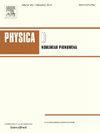奥斯特洛夫斯基-瓦赫年科方程的孤子解析
IF 2.7
3区 数学
Q1 MATHEMATICS, APPLIED
引用次数: 0
摘要
我们考虑的是以新变量 (y,τ) q3-q(logq)yτ-1=0 表示的奥斯特洛夫斯基-瓦赫年科方程(OV)的考奇问题,其初始数据为施瓦茨 q0(y)>0,支持光滑的单值孤子。研究表明,OV 方程的考奇问题解可以用一个 3 × 3 矩阵黎曼-希尔伯特(RH)问题来表征。此外,通过使用 ∂̄-steepest descent 方法将 RH 问题变形为可解模型,我们推导出了 OV 方程在两个时空区域的孤子分辨率:y/τ>0 和 y/τ<0。这一结果还意味着,OV方程在变量(y,τ)中的N个孤子解是渐近稳定的。本文章由计算机程序翻译,如有差异,请以英文原文为准。
Soliton resolution for the Ostrovsky–Vakhnenko equation
We consider the Cauchy problem of the Ostrovsky–Vakhnenko (OV) equation expressed in the new variables with Schwartz initial data which supports smooth and single-valued solitons. It is shown that the solution to the Cauchy problem for the OV equation can be characterized by a 3 × 3 matrix Riemann–Hilbert (RH) problem. Furthermore, by employing the -steepest descent method to deform the RH problem into solvable models, we derive the soliton resolution for the OV equation across two space–time regions: and . This result also implies that the -soliton solutions of the OV equation in variables are asymptotically stable.
求助全文
通过发布文献求助,成功后即可免费获取论文全文。
去求助
来源期刊

Physica D: Nonlinear Phenomena
物理-物理:数学物理
CiteScore
7.30
自引率
7.50%
发文量
213
审稿时长
65 days
期刊介绍:
Physica D (Nonlinear Phenomena) publishes research and review articles reporting on experimental and theoretical works, techniques and ideas that advance the understanding of nonlinear phenomena. Topics encompass wave motion in physical, chemical and biological systems; physical or biological phenomena governed by nonlinear field equations, including hydrodynamics and turbulence; pattern formation and cooperative phenomena; instability, bifurcations, chaos, and space-time disorder; integrable/Hamiltonian systems; asymptotic analysis and, more generally, mathematical methods for nonlinear systems.
 求助内容:
求助内容: 应助结果提醒方式:
应助结果提醒方式:


